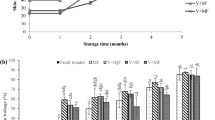Abstract
Long-life ‘Calibra’ tomatoes (Lycopersicum esculentum Mill.) were minimally fresh processed in slices or wedges and packaged in polypropylene (PP) trays. Passive and active (3 kPa O2+0 kPa CO2 and 3 kPa O2+4 kPa CO2) modified atmosphere packages (MAP) were used at 0 and 5 °C. After 14 days, the gas composition within passive MAP packages was 11–13 kPa O2+5.5–6 kPa CO2 and 8–9.5 kPa O2+10.5–11.5 kPa CO2 at 0 and 5 °C, respectively. The gas composition reached in active MAP at both temperatures for both types of cuts was around 7–10.5 kPa O2 and 7–9 kPa CO2. The highest C2H4 level (15 μL L−1) was found in passive MAP at 5 °C, while in active MAP at both temperatures about 6 μL L−1 C2H4 accumulated. After 7 days of storage at 0 °C, the tomato pieces showed better aroma, appearance and overall quality than those stored at 5 °C. No difference between MAP treatments was found, although both led to a better appearance and overall quality than controls in air. After 14 days at 0 °C, only MAP treatments kept a good flavour, overall quality and texture, with no differences between them. After 14 days at 5 °C in all treatments, the flavour fell below a fair condition and the slices showed a slight senescence. MAP significantly reduced total plate counts (TPC) of slices at 5 °C, although only active MAP reduced TPC in wedges after 14 days at 5 °C. A visibly better appearance and overall quality was found in slices than in wedges. The main factors influencing the quality of tomato pieces were the storage duration and temperature. To keep the quality of fresh-cut tomatoes, one should consider three factors for selection: a suitable low chilling sensitive tomato cultivar, an adherent placenta and optimal maturity stage at harvest.


Similar content being viewed by others
References
Nguyen-the C, Carlin F (1994) Crit Rev Food Sci Nutr 34:371–401
Watada AE, Ko PN, Minott DA (1996) Postharvest Biol Technol 9:115–125
Pittia P, Nicoli MC, Comi G, Massini R (1999) J Sci Food Agric 79:955–960
Artés F, Escriche AJ (1994) J Food Sci 59:1053–1056
Hobson GE (1987) J Hort Sci 62:55–62
Hong JH, Gross KC (2000) J Am Soc Hort Sci 125:736–741
Gil MI, Conesa MA, Artés F (2002) Postharvest Biol Technol 25:199–207
Pirovani ME, Piagentini MA, Güemes DR, Di Pentima JH (1998) J Food Quality 22:475–484
Kader AA (2002) In: Postharvest technology of horticultural crops, 3rd edn. Pub 3311. University of California, pp 135–144
Aguayo E, Allende A, Artés F (2003) Eur Food Res Technol 6:494–499
Artés F, Conesa MA, Hernández S, Gil MI (1999) Postharvest Biol Technol 17:153–162
Hong JH, Gross KC (2001) J Food Sci 66:960–965
Aguayo E, Giménez J, Artés F (2001) Alimentación Equipos Tecnología 6:83–88
Aguayo E, Escalona VH, Artés F (2001) Alimentación Equipos Tecnología 7:127–132
Conesa MA, Escalona VH, Artés F, Gil MI (2003) In: Artés F, Gil MI, Conesa, MA (eds) Improving postharvest technologies of fruits, vegetables and ornamentals, vol 1. International Institute of Refrigeration,pp 432–436
Artés F, Artés-Hernández F (2000) Alimentación Equipos Tecnología 3:135–141
RD 3484/2000 (2001) Boletín Oficial del Estado 11:1435–1441
Gorny JR (2001) In: Oosterhaven J, Peppelenbos HW (eds) Proc. 8th controlled atmosphere research conference, vol. II. Acta Hort 600 ISHS, 609–614
Kim J, Solomos T, Gross KC (1999) Postharvest Biol Technol 17:33–38
Mencarelli F, Saltveit ME (1988) J Am Soc Hort Sci 113:742–745
Rosenfeld HJ, Meberg KR, Haffner K, Sundell, HA (1999) Postharvest Biol Technol 16:27–36
Acknowledgements
The authors are grateful to CEBAS-CSIC and to Durán SAT for providing facilities and tomatoes respectively.
Author information
Authors and Affiliations
Corresponding author
Rights and permissions
About this article
Cite this article
Aguayo, E., Escalona, V. & Artés, F. Quality of fresh-cut tomato as affected by type of cut, packaging, temperature and storage time. Eur Food Res Technol 219, 492–499 (2004). https://doi.org/10.1007/s00217-004-0989-z
Received:
Revised:
Published:
Issue Date:
DOI: https://doi.org/10.1007/s00217-004-0989-z




